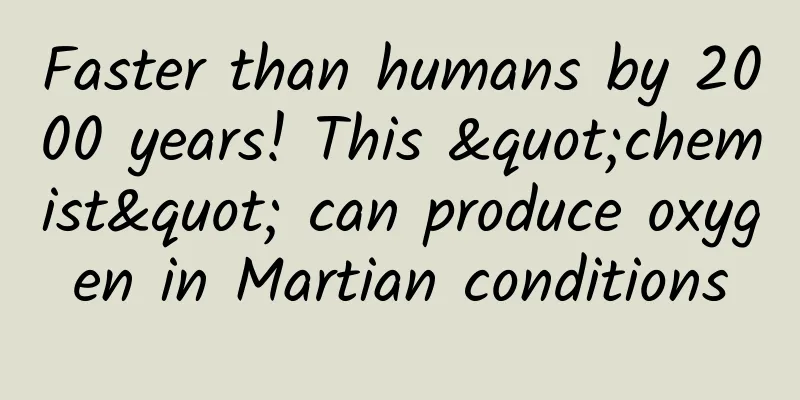Faster than humans by 2000 years! This "chemist" can produce oxygen in Martian conditions

|
Searching for signs of past life on Mars and building potential habitable areas on Mars that are suitable for survival are the long-cherished goals of mankind. Producing oxygen on Mars is one of the first problems that humans need to solve before migrating to Mars . Although NASA has previously successfully verified that oxygen can be produced locally on Mars - the oxygen production equipment on the Perseverance rover produced a total of 122 grams of oxygen in 16 oxygen production experiments (equivalent to the amount of oxygen needed for a puppy to breathe for 10 hours), there are still many difficulties in completing large-scale oxygen production on Mars . Today, artificial intelligence (AI) may be able to help us meet this challenge. A research team led by the University of Science and Technology of China has developed a robotic AI chemist that can create catalysts from Martian meteorites, test their oxygen-producing performance, and repeat the process until the best catalyst is found, without human intervention. Additionally, the researchers demonstrated that the catalyst can operate under simulated Martian conditions . In fact, designing a catalyst from a given list of elements requires exploring a huge chemical space, which is a daunting task for the traditional "trial and error" model. For example, using 5 different local Martian ores as raw materials, there are 3,764,376 possible recipes based on integer percentage combinations at 1% intervals. If this process is completed by human labor, it will take 2,000 years . The related research paper, titled “Automated synthesis of oxygen-producing catalysts from Martian meteorites by a robotic AI chemist”, has been published in Nature Synthesis, a subsidiary of Nature. The authors of the paper say AI Chemist represents a promising technology for on-site synthesis of catalysts on Mars, providing proof-of-concept for oxygen production that could impact future manned missions to Mars. Find a better formula in less than 6 weeks Since rocket propellants and life support systems consume large amounts of oxygen, oxygen supply becomes a top priority for human activities on Mars. Recent evidence of water activity raises the possibility of large-scale oxygen production on Mars via solar-driven electrochemical water oxidation using oxygen evolution reaction (OER) catalysts. However, to synthesize viable OER catalysts from local Martian raw materials, two major technical challenges must be overcome. First, the synthesis system must be unmanned and autonomously guided, as the vast astronomical distances prevent real-time remote guidance by humans; second, it should be equipped with scientific intelligence to efficiently identify the optimal catalyst recipe through AI algorithms. AI robots appear to be the only viable technology to address both challenges. These robotic systems require an intelligent subsystem to acquire chemical knowledge and form predictive physical models. The AI chemist developed in this study can realize automatic and autonomous synthesis. It can not only use mobile robots and 14 task-specific chemical workstations to carry out the entire process of chemical synthesis, structural characterization and performance testing, but also use powerful computing modules, combined with machine learning (ML) algorithms and theoretical models, to analyze the experimental data and first-principles simulation data obtained by the robot to design the best formula for chemical synthesis tasks. To simplify the work of AI chemists on Mars, the study proposed a two-layer workflow for on-site synthesis of OER electrocatalysts. The outer layer includes 12 steps of automated experiments and data management completed by robots and various "smart" chemical workstations; the inner layer includes nine consecutive digital operations performed by the intelligent computing "brain" . Figure | Workflow of a comprehensive system for AI chemists to design and produce OER electrocatalysts on-site on Mars, consisting of a mobile robot, a computing "brain", a cloud server, and 14 task-specific workstations. According to the paper, the AI chemist accelerated the discovery of the optimal synthesis formula for high-entropy electrocatalysts by five orders of magnitude compared to the traditional trial-and-error experimental paradigm . In addition, the researchers designed a data-driven protocol powered by an AI chemist, which was demonstrated to outperform the traditional trial-and-error protocol in designing an OER catalyst of six metal elements selected from 3,764,376 combinations. According to the paper, within 6 weeks, AI chemists used ML and Bayesian optimization algorithms to learn from nearly 30,000 theoretical data sets and 243 experimental data sets to build a predictive model that provides a promising OER catalyst formula and the most suitable synthesis conditions. Mars oxygen production, AI may be the "catalyst" In addition to the successful production of a small amount of oxygen by MOXIE aboard NASA's Perseverance, in 2022, Vasco Guerra, a physicist at the University of Lisbon in Portugal, and his colleagues also proposed that more oxygen could be produced using electron beams in plasma reactors. They injected air that matched the pressure and composition of Mars into a metal tube and converted about 30% of the air into oxygen by firing an electron beam into the reaction chamber. The study estimated that the device could produce about 14 grams of oxygen per hour, enough to support 28 minutes of breathing. However, while this may be sufficient to sustain a small life support system or to fuel a small rocket, a manned mission to Mars would require larger and more efficient oxygen production equipment. NASA estimates that a four-person astronaut team needs about one ton of oxygen to survive on Mars for a year, and about 7 tons of oxygen to take off from the surface of Mars and return to Earth. Therefore, future oxygen production equipment may need to be as large as a car and be able to operate stably for a long time. The AI chemist proposed in this study has achieved a new breakthrough in oxygen production on Mars, providing new ideas for producing oxygen on Mars and perhaps making large-scale production of oxygen possible . In recent years, AI has continuously expanded the possibilities of human exploration of the universe. In the future, AI may become a "catalyst" for humans to live on Mars. Reference link: https://www.nature.com/articles/s44160-023-00424-1 |
Recommend
How to make restaurant-quality ramen? Teach you to become a noodle-eating expert in 30 seconds!
Mixed Knowledge Specially designed to cure confus...
Sony is relaunching the AIBO robot dog after 12 years of discontinuation. This is a combination of "past + future"
In 1999, Sony released a companion robot, AIBO, w...
MBA Think Tank "Management Training Course" Learn management courses from famous teachers to accelerate job promotion
Take management courses from famous teachers to a...
Spent 100,000+ on private domain traffic? Wasted money!
Due to the impact of the epidemic in 2020, people...
A new round of precipitation is coming to the south! Beware of the "overlay effect" when traveling on May Day
It is the May Day holiday, but the weather is not...
What changes will the big god bring to domestic mobile phones on March 19?
Today’s domestic smartphone brands have to whet p...
Is there a health risk at work? Common office "occupational diseases", come and see if you are "hit"
In modern society, offices have become the core p...
Apple quietly lowered the price of device recycling, but will it have a big impact?
"Apple Trade In Program" is an "ol...
2019 Advertising Monetization Insights Report (Part 1)
As 2020 approaches, many media have begun plannin...
Baise Moving Mini Program investment price inquiry, how much is the Baise Moving Mini Program investment price?
What is the investment cost of Baise Moving Mini ...
How to solve the problem of poor mobile phone signal? It turns out to be so simple, I finally learned it
If the mobile phone signal is too poor, then all ...
9 major trends in short video content marketing in 2020
In 2019, all good things came at the right time. ...
A baby born with only one nostril, and this "poison of the century" that was concealed for 50 years
In 1980, a worker at chemical giant DuPont gave b...
An unspeakable question: Why does my poop always float?
After releasing yourself in the bathroom, do you ...
Are cats naturally aloof? They actually care about their owners!
Yesterday was International Cat Day (August 8th e...









